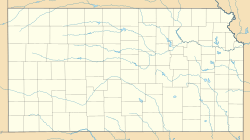Mine Creek Battlefield State Historic Site facts for kids
Quick facts for kids |
|
|
Battle of Mine Creek Site
|
|
| Nearest city | Pleasanton, Kansas |
|---|---|
| Area | 180 acres (0.73 km2) |
| Built | 1864 |
| NRHP reference No. | 73000762 |
| Added to NRHP | December 12, 1973 |
The Mine Creek Battlefield State Historic Site is a special place in eastern Kansas. It is located about 2.5 miles (4 km) southwest of Pleasanton. This site remembers the Battle of Mine Creek from the American Civil War.
On October 25, 1864, a huge cavalry battle happened here. About 2,800 Union soldiers fought against 8,000 Confederate soldiers. The Union army won this important fight. It was one of the largest cavalry battles in the Civil War. It was also the only major battle ever fought in Kansas.
Union brigades were led by Colonels Frederick W. Benteen and John Finis Philips. After this battle, Union forces chased the Confederates. They defeated them again in Missouri. The Confederates were trying to get back to Arkansas, Oklahoma, and Texas.
In 1970, Kansas decided to buy part of the battlefield. The battlefield was added to the National Register of Historic Places in 1973. More land was bought in 1974. A visitor center opened on October 24, 1998. This was 134 years after the night before the battle. As of mid-2023, the American Battlefield Trust has helped save 326 acres (132 ha) of the battlefield.
Contents
The Civil War in Kansas
General Price's Invasion Plan
On September 19, 1864, General Sterling Price led a Confederate army into Missouri. He had about 12,000 soldiers. Price hoped to take control of Missouri for the South. His orders were to get more men to join his army. If he had to leave Missouri, he was told to go through Kansas. He would take all the mules, horses, cattle, and military supplies he could find.
Price's Army Moves West
Price's army first moved toward St. Louis. On September 27, they won a battle at Pilot Knob. But the Confederates lost many soldiers there. St. Louis had also been made stronger. So, Price decided not to attack the city. He turned his army west instead. He marched along the southern side of the Missouri River. He destroyed parts of the railroad and captured small towns. He was moving closer to the Kansas border.
Kansas Prepares for Battle
When people heard about Price's army, Kansans got ready for a fight. Governor Thomas Carney called out the state militia on October 8. General Samuel R. Curtis gathered his soldiers. He formed an army called the Army of the Border.
Fighting for Kansas troops began on October 19. There was a small battle at Lexington, Missouri. The Confederates won some battles near Kansas City. This included the Battle of the Big Blue on October 22. But the Confederates were stopped at Westport on October 23. They were forced to retreat down the state line.
The Union Army Chases Price
The next day, General Curtis let most of the Kansas militia go home. He reorganized his army. General James G. Blunt led the First Division. General Alfred Pleasonton led the Second Division. The Union army chasing Price had about 10,000 cavalry soldiers.
The Battle of Mine Creek
The Chase into Kansas
On October 24, Price's army crossed into Linn County, Kansas. They camped near Trading Post. Before sunrise on October 25, the Union army caught up to them. A running battle started and lasted all day.
The most important part of the battle happened late in the morning. General John S. Marmaduke was a Confederate leader. He had to fight to protect Price's wagon train. The wagons were full of supplies and things they had taken. General James Fleming Fagan's division helped Marmaduke. These two Confederate groups had about 7,000 men.
A Fierce Cavalry Charge
The Union army, led by General Pleasonton, had fewer than 2,500 soldiers. But they charged with great force. Colonel Charles W. Blair of the 14th Kansas Cavalry described the fight. He said the firing was "incessant and terrific." He felt both sides were like "walls of adamant." One side could not move forward, and the other would not give up.
Colonel F. W. Benteen's brigade was the first to meet the enemy. He called it a "fierce hand-to-hand fight." He said it was more intense than anything he had ever seen for its length.
The Confederate Retreat
The battle was over in less than an hour. Confederate soldiers ran away in "utter and indescribable confusion," according to General Price. His army almost faced total destruction.
Price continued his retreat. He had to give up his plan to attack Fort Scott. His troops purposely destroyed most of their wagon train. This included their supplies and stolen goods. After a short rest, Generals Curtis and Blunt kept chasing them. On October 28, they defeated Price one last time at Newtonia, Missouri. The Confederate army crossed the Arkansas River on November 8. For most purposes, the Civil War in the West was now over.



